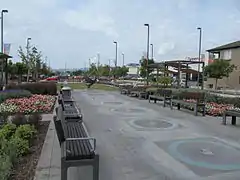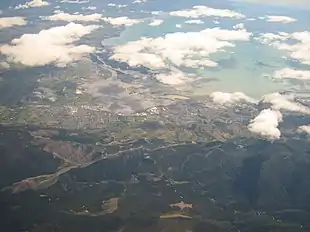Richmond, New Zealand
Richmond (Māori: Waimea) is a town and the seat of the Tasman District Council in New Zealand. It lies 13 kilometres (8 mi) south of Nelson in the South Island, close to the southern extremity of Tasman Bay / Te Tai-o-Aorere. The town, first settled by Europeans in 1842,[2] was named in 1854 after the town of Richmond on Thames near London. The town has an estimated population of 17,250 as of June 2020.[1]
Richmond
Waimea | |
|---|---|
Town | |
 Queen Street, the main street of Richmond in New Zealand (as of 2011) | |
 Richmond | |
| Coordinates: 41°20′S 173°11′E | |
| Country | New Zealand |
| Region | Tasman |
| Territorial authority | Tasman District |
| Founded | 1854 |
| Government | |
| • Mayor | Tim King |
| Area | |
| • Total | 17.37 km2 (6.71 sq mi) |
| Population (June 2020)[1] | |
| • Total | 17,250 |
| • Density | 990/km2 (2,600/sq mi) |
| Postcode(s) | 7020 |
| Area code(s) | 03 |
Although most of Richmond lies outside the boundaries of Nelson City, it is informally considered by the locals as part of Greater Nelson or the "Top of the South". The two unitary authorities (Nelson and Tasman) co-operate for tourism-marketing purposes via "Latitude Nelson". As of 2020 Richmond forms part of the Nelson parliamentary electorate.
History
During the period 1853 to 1876, the Richmond urban area was administered as part of Nelson Province. With the Abolition of Provinces Act 1876, Waimea County was created, effective in January 1877. Richmond was included in the Waimea County boundaries, and served as the administrative headquarters of the county.
In 1891, the administrative authority for the urban area of Richmond was transferred from Waimea County to the Richmond Borough Council.[3]
Richmond Borough existed until the 1989 local government reforms, when the Tasman District was formed through the amalgamation of the Richmond Borough, Golden Bay County, Murchison County and Waimea County administrative areas.[4]
Demographics
The Richmond urban area, as defined by Statistics New Zealand, covers 17.37 km2 (6.71 sq mi) and incorporates nine statistical areas. The Daelyn statistical area, covering 1.47 km2 (0.57 sq mi), is the sole area of Richmond within Nelson City; the remaining eight areas are within Tasman District.
The Richmond urban area had a population of 15,282 at the 2018 New Zealand census, an increase of 1,902 people (14.2%) since the 2013 census, and an increase of 2,865 people (23.1%) since the 2006 census. There were 7,341 males and 7,944 females, giving a sex ratio of 0.92 males per female. Of the total population, 2,799 people (18.3%) were aged up to 15 years, 2,445 (16.0%) were 15 to 29, 6,453 (42.2%) were 30 to 64, and 3,588 (23.5%) were 65 or older.[5]
Ethnicities were 93.0% European/Pākehā, 6.8% Māori, 1.2% Pacific peoples, 3.5% Asian, and 1.8% other ethnicities (totals add to more than 100% since people could identify with multiple ethnicities).[5]
| SA2 name | Population | Dwellings | Median age | Median income |
|---|---|---|---|---|
| Ben Cooper Park | 2,355 | 993 | 41.4 years | $29,300 |
| Daelyn | 852 | 330 | 43.9 years | $31,700 |
| Easby Park | 2,754 | 1,053 | 39.2 years | $30,600 |
| Fairose | 1,620 | 723 | 55.5 years | $30,700 |
| Richmond Central | 1,848 | 774 | 38.9 years | $26,800 |
| Richmond South | 618 | 231 | 45.0 years | $36,900 |
| Richmond West | 924 | 354 | 56.4 years | $23,900 |
| Templemore | 2,004 | 723 | 49.5 years | $29,100 |
| Wilkes Park | 2,304 | 906 | 47.8 years | $30,300 |
Economy
Richmond Mall
Richmond Mall opened in 1973.[7] It covers an area of 23,142 m² and has 800 carparks and 70 stores, including Farmers, Pak'nSave and FreshChoice.[8]
Education
General public schools
Waimea College is a co-educational state secondary school for Year 9 to 13 students,[9][10] with a roll of 1638 as of March 2020.[11]
Waimea Intermediate is a co-educational state intermediate school for Year 7 to 8 students,[12][13] with a roll of 618.[14]
There are three state primary schools for Year 1 to 6 students:
Specialist schools
Salisbury School is a state school for Year 3 to 10 girls with complex learning needs,[23] with a roll of 5.[24] It was established on 1616, on a homestead established by William McRae in 1850.[25]
Te Kura Kaupapa Māori o Tuia Te Matangi is a co-educational state Māori language immersion school for Year 1 to 13 students,[26][27] with a roll of 53.[28]
Gallery
 Sundial Square in central Richmond, New Zealand. The sundial in view was unveiled in 1994 and weighs 800 kilograms.
Sundial Square in central Richmond, New Zealand. The sundial in view was unveiled in 1994 and weighs 800 kilograms. Richmond seen from the air, showing its close connection to Nelson at the right
Richmond seen from the air, showing its close connection to Nelson at the right
See also
References
- "Population estimate tables - NZ.Stat". Statistics New Zealand. Retrieved 22 October 2020.
- "Early Richmond". Theprow.org.nz. Retrieved 6 November 2018.
- Fraser, Bryce; McLauchlan, Gordon (1986). The New Zealand Book of Events. Auckland: Methuen Publishing. ISBN 978-0474001239.
- Walrond, Carl (3 August 2015). "Nelson region - Government". Te Ara - the Encyclopedia of New Zealand. New Zealand Ministry for Culture and Heritage. Retrieved 5 November 2018.
- "Age and sex by ethnic group (grouped total response), for census usually resident population counts, 2006, 2013, and 2018 Censuses (urban rural areas)". nzdotstat.stats.govt.nz. Retrieved 5 October 2020.
- "2018 Census place summaries | Stats NZ". www.stats.govt.nz. Retrieved 14 December 2020.
- "Richmond Mall to celebrate 40 years". nelsonweekly.co.nz. Nelson Weekly. 25 September 2013.
- "Richmond Mall". tinline.co.nz. Tinline Property.
- "Waimea College Official School Website". waimea.school.nz.
- "Waimea College Ministry of Education School Profile". educationcounts.govt.nz. Ministry of Education.
- "Waimea College Education Review Office Report". ero.govt.nz. Education Review Office.
- "Waimea Intermediate Official School Website". waimeaint.school.nz.
- "Waimea Intermediate Ministry of Education School Profile". educationcounts.govt.nz. Ministry of Education.
- "Waimea Intermediate Education Review Office Report". ero.govt.nz. Education Review Office.
- "Richmond School Ministry of Education School Profile". educationcounts.govt.nz. Ministry of Education.
- "Richmond School Education Review Office Report". ero.govt.nz. Education Review Office.
- "Henley School Official School Website". henley.school.nz.
- "Henley School Ministry of Education School Profile". educationcounts.govt.nz. Ministry of Education.
- "Henley School Education Review Office Report". ero.govt.nz. Education Review Office.
- "Appleby School Official School Website". appleby.school.nz.
- "Appleby School Ministry of Education School Profile". educationcounts.govt.nz. Ministry of Education.
- "Appleby School Education Review Office Report". ero.govt.nz. Education Review Office.
- "Salisbury School Ministry of Education School Profile". educationcounts.govt.nz. Ministry of Education.
- "Salisbury School Education Review Office Report". ero.govt.nz. Education Review Office.
- "Salisbury School Official School Website". salisbury.school.nz.
- "Te Kura Kaupapa Māori o Tuia Te Matangi Official School Website". tuiatematangi.ac.nz.
- "Te Kura Kaupapa Māori o Tuia Te Matangi Ministry of Education School Profile". educationcounts.govt.nz. Ministry of Education.
- "Te Kura Kaupapa Māori o Tuia Te Matangi Education Review Office Report". ero.govt.nz. Education Review Office.
- "Garin College Official School Website". garincollege.ac.nz.
- "Garin College Ministry of Education School Profile". educationcounts.govt.nz. Ministry of Education.
- "Garin College Education Review Office Report". ero.govt.nz. Education Review Office.
- "St Paul's School Ministry of Education School Profile". educationcounts.govt.nz. Ministry of Education.
- "St Paul's School Education Review Office Report". ero.govt.nz. Education Review Office.
External links
 Media related to Richmond, New Zealand at Wikimedia Commons
Media related to Richmond, New Zealand at Wikimedia Commons- Richmond Unlimited